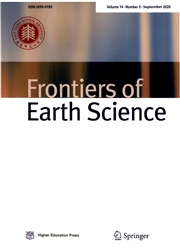Cloud type identification for a landfalling typhoon based on millimeter-wave radar range-height-indicator data
作者:Zhoujie CHENG,Ming WEI,Yaping ZHU,Jie BAI,Xiaoguang SUN,Li GAO
摘要:As a basic property of cloud,accurate identification of cloud type is useful in forecasting the evolution of landfalling typhoons.Millimeter-wave cloud radar is an important means of identifying cloud type.Here,we develop a fuzzy logic algorithm that depends on radar range-height-indicator(RHI)data and takes into account the fundamental physical features of different cloud types.The algorithm is applied to a ground-based Ka-band millimeter-wave cloud radar.The input parameters of the algorithm include average reflectivity factor intensity,ellipse long axis orientation,cloud base height,cloud thickness,presence/absence of precipitation,ratio of horizontal extent to vertical extent,maximum echo intensity,and standard variance of intensities.The identified cloud types are stratus(St),stratocumulus(Sc),cumulus(Cu),cumulonimbus(Cb),nimbostratus(Ns),altostratus(As),altocumulus(Ac)and high cloud.The cloud types identified using the algorithm are in good agreement with those identified by a human observer.As a case study,the algorithm was applied to typhoon Khanun(1720),which made landfall in south-eastern China in October 2017.Sequential identification results from the algorithm clearly reflected changes in cloud type and provided indicative information for forecasting of the typhoon.
发文机构:Collaborative Innovation Center on Forecast and Evaluation of Meteorological Disasters Beijing Institute of Aviation Meteorology Beijing Marine Hydrometeorologic Centre Beijing Meteorological Centre Taizhou Meteorological Bureau of Zhejiang Province
关键词:landfallingTYPHOONidentificationofCLOUDtypeMILLIMETER-WAVECLOUDradarRHIDATAfuzzylogic
分类号: TP3[自动化与计算机技术—计算机科学与技术]
- Spatiotemporal influences of land use/cover changes on the heat island effect in rapid urbanization area
- A simplified index to assess the combined impact of tropical cyclone precipitation and wind on China
- Land use and land cover classification using Chinese GF-2 multispectral data in a region of the North China Plain
- Erosion-deposition patterns and depo-center movements in branching channels at the near-estuary reach of the Yangtze River
- Metal accumulation in Asiatic clam from the Lower Min River (China) and implications for human health
- Estimation of copper concentration of rocks using hyperspectral technology
- Chemical and minero-petrographical changes on granulite rocks affected by weathering processes
- BMA probability quantitative precipitation forecasting of land-falling typhoons in south-east China
- Accumulation of unconventional petroleum resources and their coexistence characteristics in Chang7 shale formations of Ordos Basin in central China
- Improvement of typhoon rainfall prediction based on optimization of the Kain-Fritsch convection parameterization scheme using a micro-genetic algorithm


